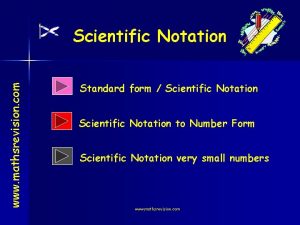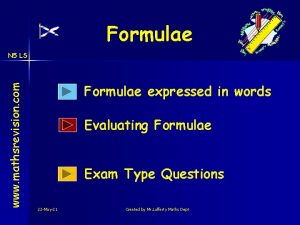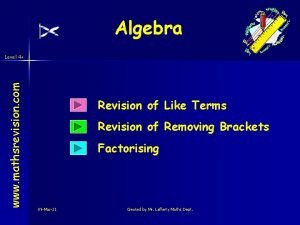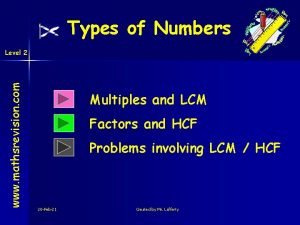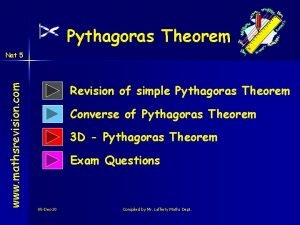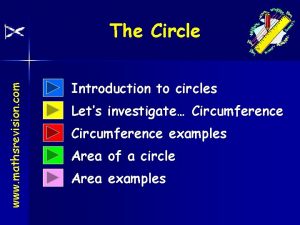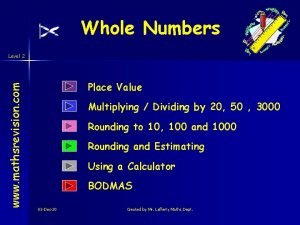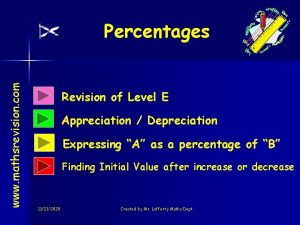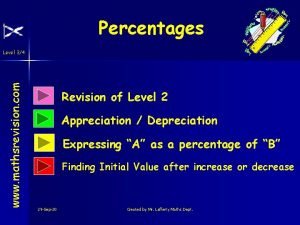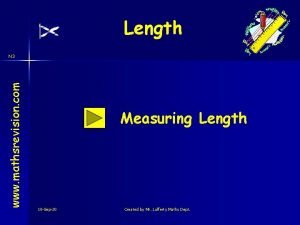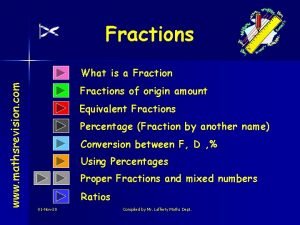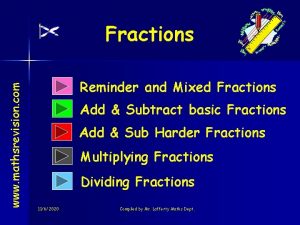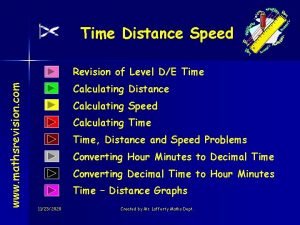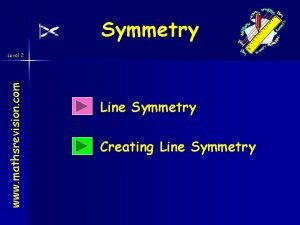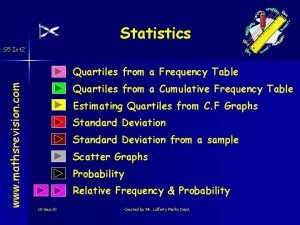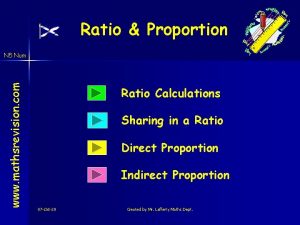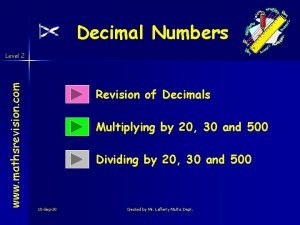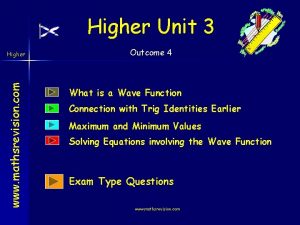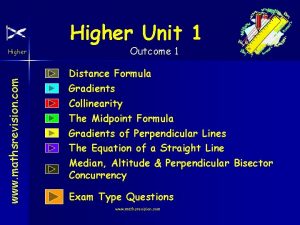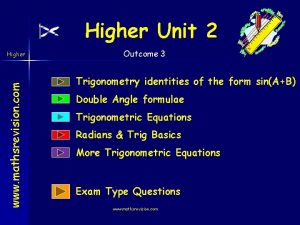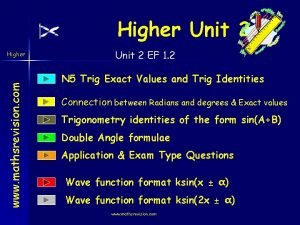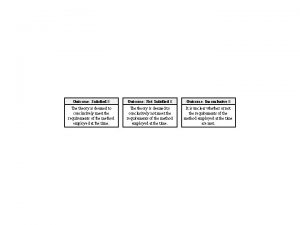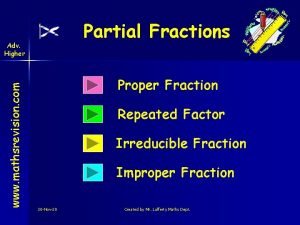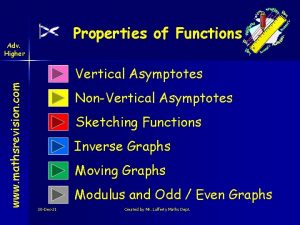Higher Unit 2 Outcome 1 Higher www mathsrevision





















































- Slides: 53

Higher Unit 2 Outcome 1 Higher www. mathsrevision. com What is a polynomials Evaluating / Nested / Synthetic Method Factor Theorem Factorising higher Orders Factors of the form (ax + b) Finding Missing Coefficients Finding Polynomials from its zeros Credit Quadratic Theory Completing the square Discriminant Condition for Tangency

Polynomials Higher Definition Outcome 1 www. mathsrevision. com A polynomial is an expression with several terms. These will usually be different powers of a particular letter. The degree of the polynomial is the highest power that appears. Examples 3 x 4 – 5 x 3 + 6 x 2 – 7 x - 4 Polynomial in x of degree 4. 7 m 8 – 5 m 5 – 9 m 2 + 2 Polynomial in m of degree 8. w 13 – 6 Polynomial in w of degree 13. NB: It is not essential to have all the powers from the highest down, however powers should be in descending order.

Disguised Polynomials www. mathsrevision. com Higher Outcome 1 (x + 3)(x – 5)(x + 5)= (x + 3)(x 2 – 25)= x 3 + 3 x 2 – 25 x - 75 So this is a polynomial in x of degree 3. Coefficients In the polynomial 3 x 4 – 5 x 3 + 6 x 2 – 7 x – 4 we say that the coefficient of x 4 is 3 the coefficient of x 3 is -5 the coefficient of x 2 is 6 the coefficient of x is -7 and the coefficient of x 0 is -4 (NB: x 0 = 1) In w 13 – 6 , the coefficients of w 12, w 11, …. w 2, w are all zero.

Evaluating Polynomials Outcome 1 www. mathsrevision. com Higher Suppose that g(x) = 2 x 3 - 4 x 2 + 5 x - 9 Substitution Method g(2) = (2 X 2 X 2) – (4 X 2 ) + (5 X 2) - 9 = 16 – 16 + 10 - 9 = 1 NB: this requires 9 calculations.

Nested or Synthetic Method Outcome 1 www. mathsrevision. com Higher This involves using the coefficients and requires fewer calculations so is more efficient. It can also be carried out quite easily using a calculator. g(x) = 2 x 3 - 4 x 2 + 5 x - 9 Coefficients are 2, -4, 5, -9 g(2) = 2 2 -4 5 -9 4 0 5 10 0 1 This requires only 6 calculations so is 1/3 more efficient.

Nested or Synthetic Method Outcome 1 www. mathsrevision. com Higher Example If f(x) = 2 x 3 - 8 x then the coefficients are and 2 0 f(2) = 2 2 0 -8 0 0 2 4 4 0 -8 0

Factor Theorem Outcome 1 Higher www. mathsrevision. com If (x – a) is a factor of the polynomial f(x) Then f(a) = 0. Reason Say f(x) = a 3 x 3 + a 2 x 2 + a 1 x + a 0 = (x – a)(x – b)(x – c) polynomial form factorised form Since (x – a), (x – b) and (x – c) are factors then f(a) = f(b) = f(c ) = 0 Check f(b) = (b – a)(b – b)(b – c) = (b – a) X 0 X (b – c) = 0

Factor Theorem Outcome 1 Higher www. mathsrevision. com Now consider the polynomial f(x) = x 3 – 6 x 2 – x + 30 = (x – 5)(x – 3)(x + 2) So f(5) = f(3) = f(-2) = 0 The polynomial can be expressed in 3 other factorised forms A f(x) = (x – 5)(x 2 – x – 6) B f(x) = (x – 3)(x 2 – 3 x – 10) C f(x) = (x + 2)(x 2 – 8 x + 15) These can be checked by multiplying out the brackets ! Keeping coefficients in mind an interesting thing occurs when we calculate f(5) , f(3) and f(-2) by the nested method.

Factor Theorem Outcome 1 www. mathsrevision. com Higher A f(5) = 5 1 1 -6 5 -1 Other factor is x 2 – x - 6 = (x – 3)(x + 2) -1 -5 -6 30 -30 0 f(5) = 0 so (x – 5) a factor

Factor Theorem Outcome 1 www. mathsrevision. com Higher B f(3) = 3 1 -6 3 -1 -9 30 -30 1 -3 -10 0 Other factor is x 2 – 3 x - 10 f(3) = 0 so (x – 3) a factor = (x – 5)(x + 2)

Factor Theorem Outcome 1 www. mathsrevision. com Higher C f(-2) = -2 1 1 -6 -2 -8 -1 16 15 30 -30 0 Other factor is x 2 – 8 x + 15 f(-2) = 0 so (x +2) a factor = (x – 3)(x - 5) This connection gives us a method of factorising polynomials that are more complicated then quadratics ie cubics, quartics and others.

Factor Theorem www. mathsrevision. com Higher Outcome 1 Example Factorise x 3 + 3 x 2 – 10 x - 24 We need some trial & error with factors of – 24 ie +/-1, +/-2, +/-3 etc f(-1) = -1 1 1 f(1) = 1 1 1 3 -1 2 -10 -2 -12 -24 12 -12 No good 3 1 4 -10 4 -6 -24 -6 -30 No good

Factor Theorem Outcome 1 Higher www. mathsrevision. com f(-2) = -2 1 1 Other factor is So 3 -2 1 -10 -2 -12 x 2 + x - 12 -24 24 0 f(-2) = 0 so (x + 2) a factor = (x + 4)(x – 3) x 3 + 3 x 2 – 10 x – 24 = (x + 4)(x + 2)(x – 3) Roots/Zeros The roots or zeros of a polynomial tell us where it cuts the X-axis. ie where f(x) = 0. If a cubic polynomial has zeros a, b & c then it has factors (x – a), (x – b) and (x – c).

We need some trial & error with factors of – 9 ie Factorising Higher Orders Outcome 1 Higher +/-1, +/-3 etc www. mathsrevision. com Example Solve f(-1) = -1 x 4 + 2 x 3 - 8 x 2 – 18 x – 9 = 0 1 2 -1 -8 -1 1 1 -9 -18 9 -9 -9 9 0 f(-1) = 0 so (x + 1) a factor Other factor is x 3 + x 2 – 9 x - 9 which we can call g(x) test +/-1, +/-3 etc

Factorising Higher Orders Outcome 1 www. mathsrevision. com Higher g(-1) = -1 1 1 -1 -9 0 -9 9 1 0 -9 0 g(-1) = 0 so (x + 1) a factor Other factor is x 2 – 9 = (x + 3)(x – 3) if x 4 + 2 x 3 - 8 x 2 – 18 x – 9 = 0 then (x + 3)(x + 1)(x – 3) = 0 So x = -3 or x = -1 or x = 3

Factorising Higher Orders www. mathsrevision. com Higher Summary Outcome 1 A cubic polynomial ie ax 3 + bx 2 + cx + d could be factorised into either (i) Three linear factors of the form (x + a) or (ax + b) or (ii) A linear factor of the form (x + a) or (ax + b) and a quadratic factor (ax 2 + bx + c) which doesn’t factorise. or IT DIZNAE (iii) It may be irreducible. FACTORISE

Linear Factors in the form (ax + b) Outcome 1 www. mathsrevision. com Higher If (ax + b) is a factor of the polynomial f(x) then f(-b/a) = 0 Reason Suppose f(x) = (ax + b)(………. . ) If f(x) = 0 then (ax + b)(………. . ) = 0 So (ax + b) = 0 or (……. ) = 0 so ax = -b so x = -b/a NB: When using such factors we need to take care with the other coefficients.

Linear Factors in the form (ax + b) www. mathsrevision. com Higher Outcome 1 Example Show that (3 x + 1) is a factor of g(x) = 3 x 3 + 4 x 2 – 59 x – 20 and hence factorise the polynomial completely. Since (3 x + 1) is a factor then g(-1/3) should equal zero. g(-1/3) = -1/ 3 3 3 4 -1 3 -59 -1 -60 3 x 2 + 3 x - 60 -20 20 0 g(- 1/3) = 0 so (x + 1/3) is a factor

Linear Factors in the form (ax + b) Outcome 1 www. mathsrevision. com Higher Other factor is 3 x 2 + 3 x - 60 = 3(x 2 + x – 20) = 3(x + 5)(x – 4) NB: common factor Hence g(x) = (x + 1/3) X 3(x + 5)(x – 4) = (3 x + 1)(x + 5)(x – 4)

Missing Coefficients Higher Example Outcome 1 www. mathsrevision. com Given that (x + 4) is a factor of the polynomial f(x) = 2 x 3 + x 2 + ax – 16 find the value of a and hence factorise f(x). Since f(-4) = (x + 4) a factor then 2 a 28 (a + 28) -4 2 1 -8 -7 f(-4) = 0. -16 (-4 a – 112) (-4 a – 128)

Missing Coefficients Outcome 1 www. mathsrevision. com Higher Since -4 a – 128 = 0 then 4 a = -128 so a = -32 If a = -32 then the other factor is 2 x 2 – 7 x - 4 = (2 x + 1)(x – 4) So f(x) = (2 x + 1)(x + 4)(x – 4)

Missing Coefficients Higher Outcome 1 Example www. mathsrevision. com (x – 4) is a factor of f(x) = x 3 + ax 2 + bx – 48 while f(-2) = -12. Find a and b and hence factorise f(x) completely. (x – 4) a factor so f(4) = 0 f(4) = 4 1 1 a 4 b (4 a + 16) (a + 4) (4 a + b + 16) 16 a + 4 b + 16 = 0 ( 4) 4 a + b + 4 = 0 4 a + b = -4 -48 (16 a + 4 b + 64) (16 a + 4 b + 16)

Missing Coefficients Outcome 1 Higher www. mathsrevision. com f(-2) = -12 so f(-2) = -2 1 1 a -2 b (-2 a + 4) -48 (4 a - 2 b - 8) (a - 2) (-2 a + b + 4) (4 a - 2 b - 56) 4 a - 2 b - 56 = -12 ( 2) 2 a - b - 28 = -6 2 a - b = 22 We now use simultaneous equations ….

Missing Coefficients Outcome 1 www. mathsrevision. com Higher 4 a + b = -4 2 a - b = 22 add 6 a = 18 a=3 Using 4 a + b = -4 12 + b = -4 b = -16 When (x – 4) is a factor the quadratic factor is x 2 + (a + 4)x + (4 a + b + 16) = x 2 + 7 x + 12 =(x + 4)(x + 3) So f(x) = (x - 4)(x + 3)(x + 4)

Finding a Polynomial From Its Zeros www. mathsrevision. com Higher Caution Suppose that f(x) = x 2 + 4 x - 12 Outcome 1 and g(x) = -3 x 2 - 12 x + 36 f(x) = 0 g(x) = 0 x 2 + 4 x – 12 = 0 -3 x 2 - 12 x + 36 = 0 (x + 6)(x – 2) = 0 -3(x 2 + 4 x – 12) = 0 x = -6 or x = 2 -3(x + 6)(x – 2) = 0 x = -6 or x = 2 Although f(x) and g(x) have identical roots/zeros they are clearly different functions and we need to keep this in mind when working backwards from the roots.

Finding a Polynomial From Its Zeros www. mathsrevision. com Higher Outcome 1 If a polynomial f(x) has roots/zeros at a, b and c then it has factors (x – a), (x – b) and (x – c) And can be written as f(x) = k(x – a)(x – b)(x – c). NB: In the two previous examples k = 1 and k = -3 respectively.

Finding a Polynomial From Its Zeros Outcome 1 Higher www. mathsrevision. com Example y = f(x) 30 -2 1 5

Finding a Polynomial From Its Zeros Outcome 1 www. mathsrevision. com Higher f(x) has zeros at x = -2, x = 1 and x = 5, so it has factors (x +2), (x – 1) and (x – 5) so f(x) = k (x +2)(x – 1)(x – 5) f(x) also passes through (0, 30) so replacing x by 0 and f(x) by 30 the equation becomes 30 = k X 2 X (-1) X (-5) ie 10 k = 30 ie k=3

Finding a Polynomial From Its Zeros Outcome 1 www. mathsrevision. com Higher Formula is f(x) = 3(x + 2)(x – 1)(x – 5) f(x) = (3 x + 6)(x 2 – 6 x + 5) f(x) = 3 x 3 – 12 x 2 – 21 x + 30

Roots (0, ) Max. Point (0, ) x= x= f(x) = x 2 + 4 x + 3 f(-2) =(-2)2 + 4 x(-2) + 3 = -1 a>0 Mini. Point Line of Symmetry half way between roots a<0 Line of Symmetry half way between roots Evaluating Graphs Quadratic Functions y = ax 2 + bx + c Decimal places Cannot Factorise SAC e. g. (x+1)(x-2)=0 Roots x = -1 and x = 2 Factorisation ax 2 + bx + c = 0 Roots x = -1. 2 and x = 0. 7

Completing the Square Higher Outcome 1 www. mathsrevision. com This is a method for changing the format of a quadratic equation so we can easily sketch or read off key information Completing the square format looks like f(x) = a(x + b)2 + c Warning ! The a, b and c values are different from the a , b and c in the general quadratic function

Completing the Square Outcome 1 Higher www. mathsrevision. com Complete the square for x 2 + 2 x + 3 and hence sketch function. f(x) = a(x + b)2 + c Half the x term and square the coefficient. Compensate Tidy up ! x 2 + 2 x + 3 x 2 + 2 x +3 (x 2 + 2 x + 1) -1 + 3 (x + 1)2 + 2 a=1 b=1 c=2

Completing the Square Outcome 1 www. mathsrevision. com Higher sketch function. f(x) = a(x + b)2 + c = (x + 1)2 + 2 (0, 3) Mini. Pt. ( -1, 2) (-1, 2)

Completing the Square Higher Outcome 1 www. mathsrevision. com Complete the square for 2 x 2 - 8 x + 9 and hence sketch function. f(x) = a(x + b)2 + c 2 x 2 - 8 x + 9 2 - 8 x 2 x +9 Half the x term Take out 2(x 2 - 4 x) + 9 and square the coefficient of Tidy up ! Compensate coefficient. 2 2(x 2 – 4 x + 4) - 8 + 9 x term. 2(x - 2)2 + 1 a=2 b=2 c=1

Completing the Square Outcome 1 www. mathsrevision. com Higher sketch function. f(x) = a(x + b)2 + c (0, 9) = 2(x - 2)2 + 1 Mini. Pt. ( 2, 1) (2, 1)

Completing the Square Higher Outcome 1 www. mathsrevision. com Complete the square for 7 + 6 x – x 2 and hence sketch function. f(x) = a(x + b)2 + c -x 2 + 6 x + 7 2 + 6 x -x +7 Half. Take the x term out 2 - 6 x) -(x +7 2 and square the coefficient of x a = -1 Tidy up compensate coefficient -(x 2 – 6 x + 9) + 9 + 7 b=3 -(x - 3)2 + 16 c = 16

Completing the Square Outcome 1 www. mathsrevision. com Higher sketch function. f(x) = a(x + b)2 + c = -(x - 3)2 + 16 Mini. Pt. ( 3, 16) (0, 7)

Quadratic Theory Given Higher , express in the form Hence sketch function. (0, -8) (-1, 9)

Quadratic Theory a) Write Higher in the form (0, 11) b) Hence or otherwise sketch the graph of a) b) (-3, 2) For the graph of moved 3 places to left and 2 units up. minimum t. p. at (-3, 2)y-intercept at (0, 11)

Using Discriminants www. mathsrevision. com Higher Outcome 1 Given the general form for a quadratic function. f(x) = ax 2 + bx + c We can calculate the value of the discriminant b 2 – 4 ac This gives us valuable information about the roots of the quadratic function

Roots of a quadratic Function Outcome 1 Higher www. mathsrevision. com There are 3 possible scenarios 2 real and 2 equal real roots distinct roots discriminant (b 2 - 4 ac > 0) discriminant (b 2 - 4 ac = 0) No real roots discriminant (b 2 - 4 ac < 0) To determine whether a quadratic function has 2 real roots, 2 equal real roots or no real roots we calculate the discriminant.

Discriminant Outcome 1 Higher www. mathsrevision. com Find the value p given that 2 x 2 + 4 x + p = 0 has real roots a=2 For real roots b=4 c=p b 2 – 4 ac ≥ 0 16 – 8 p ≥ 0 -8 p ≥ -16 p≤ 2 The equation has real roots when p ≤ 2.

Discriminant Outcome 1 Higher www. mathsrevision. com Find w given that x 2 + (w – 3)x + w = 0 has non-real roots a = 1 b = (w – 3) For non-real roots c=w b 2 – 4 ac < 0 (w – 3)2 – 4 w < 0 w 2 – 6 w +9 - 4 w < 0 w 2 – 10 w + 9 < 0 (w – 9)(w – 1) < 0 From graph non-real roots when 1 < w < 9

Discriminant Outcome 1 Higher www. mathsrevision. com Show that the roots of (k - 2)x 2 – (3 k - 2)x + 2 k = 0 a = (k – 2) Are always real b = – (3 k – 2) c = 2 k b 2 – 4 ac = [– (3 k – 2) ]2 – 4(k – 2)(2 k) = 9 k 2 – 12 k + 4 - 8 k 2 + 16 k = k 2 + 4 k + 4 = (k + 2)2 Since square term b 2 – 4 ac ≥ 0 and roots ALWAYS real.

Quadratic Theory Higher Show that the equation has real roots for all integer values of k Use discriminant Consider when this is greater than or equal to zero Sketch graph cuts x axis at Hence equation has real roots for all integer k

Quadratic Theory For what value of k does the equation Discriminant For equal roots discriminant = 0 Higher have eq

Condition for Tangency Outcome 1 www. mathsrevision. com Higher 2 real and distinct roots discriminant (b 2 - 4 ac > 0) 2 equal real roots No real roots discriminant (b 2 - 4 ac = 0) discriminant (b 2 - 4 ac < 0) If the discriminant b 2 – 4 ac = 0 then 2 equal real roots and therefore a point of tangency exists.

Examples to prove Tangency Higher Outcome 1 Prove that the line is a tangent to the curve. www. mathsrevision. com Make the two functions equal to each other. x 2 + 3 x + 2 = x + 1 x 2 + 3 x + 2 – x - 1 = 0 x 2 + 2 x + 1 = 0 b 2 – 4 ac = (2)2 – 4(1)(1) =0 Since 2 equal real roots line is tangent to curve.

Examples to prove Tangency Outcome 1 Higher www. mathsrevision. com Prove that y = 2 x - 1 is a tangent to the curve y = x 2 and find the intersection point x 2 = 2 x - 1 x 2 - 2 x + 1 = 0 (x – 1)2 = 0 x=1 Since 2 equal real root hence tangent 2 b - 4 ac = (-2)2 -4(1)(1) = 0 hence tangent For x = 1 then y = (1)2 = 1 so intersection point is (1, 1) Or x = 1 then y = 2 x 1 - 1 = 1 so intersection point is (1, 1)

Tangent line has equation. Examples of the form y = 2 x + k to prove Tangency Higher Outcome 1 www. mathsrevision. com Find the equation of the tangent to y = x 2 + 1 that has gradient 2. x 2 + 1 = 2 x + k x 2 - 2 x + (1 – k) = 0 a=1 b=– 2 Since 2 equal real root hence tangent c = (1 – k) b 2 – 4 ac = (– 2)2 – 4(1 – k) = 0 4 – 4 + 4 k = 0 k=0 Tangent equation is y = 2 x

Quadratic Theory Show that the line with equation does not intersect the parabola with equation Put two equations equal Use discriminant Show discriminant < 0 No real roots Higher

Quadratic Theory Higher The diagram shows a sketch of a parabola passing through (– 1, 0), (0, p) and (p, 0). a) Show that the equation of the parabola is b) For what value of p will the line be a tangent to this curve? a) Use point (0, p) to find k b) Simultaneous equations Discriminant = 0 for tangency

Are you on Target ! Outcome 1 www. mathsrevision. com Higher • Update you log book • Make sure you complete and correct ALL of the Polynomials questions in the past paper booklet.
 How is 120 700 written in scientific notation
How is 120 700 written in scientific notation Mathsrevision.com
Mathsrevision.com Mathsrevision.com
Mathsrevision.com Mathsrevision.com
Mathsrevision.com Mathsrevision.com level 2
Mathsrevision.com level 2 National 5 maths pythagoras
National 5 maths pythagoras Mathsrevision.com level 2
Mathsrevision.com level 2 Function machine algebra
Function machine algebra Introduction of circle
Introduction of circle Maths revision.com
Maths revision.com Mathsrevision.com level 2
Mathsrevision.com level 2 Mathsrevision.com level 3
Mathsrevision.com level 3 Mathsrevision.com
Mathsrevision.com Mathsrevision.com
Mathsrevision.com Appreciation and depreciation maths
Appreciation and depreciation maths Www.mathsrevision.com
Www.mathsrevision.com Www.mathsrevision.com
Www.mathsrevision.com N3learning
N3learning Www.mathsrevision.com
Www.mathsrevision.com Mathsrevision
Mathsrevision Www.mathsrevision.com
Www.mathsrevision.com Mathsrevision.com
Mathsrevision.com Tolerance in maths
Tolerance in maths Www.mathsrevision.com
Www.mathsrevision.com Vertical line
Vertical line Statistics
Statistics Mathsrevision.com
Mathsrevision.com Mathsrevision.com
Mathsrevision.com Www.mathsrevision.com
Www.mathsrevision.com Www.mathsrevision.com
Www.mathsrevision.com Natsip
Natsip Decimal revision
Decimal revision Www.mathsrevision.com
Www.mathsrevision.com Unit 10, unit 10 review tests, unit 10 general test
Unit 10, unit 10 review tests, unit 10 general test Indikator outcome kotaku
Indikator outcome kotaku Examples of resistance to imperialism
Examples of resistance to imperialism George w. mclaurin
George w. mclaurin Research project outcome
Research project outcome Cosimo de' medici
Cosimo de' medici The reformation outcome martin luther and the reformation
The reformation outcome martin luther and the reformation Outcome of prisoner's dilemma
Outcome of prisoner's dilemma Duty of care certificate
Duty of care certificate Kpi kotaku
Kpi kotaku Predicted outcome value theory
Predicted outcome value theory A government-created monopoly arises when
A government-created monopoly arises when Outcome star
Outcome star Contoh input, proses dan output dalam kesehatan
Contoh input, proses dan output dalam kesehatan Outcomes based education for teacher preparation curriculum
Outcomes based education for teacher preparation curriculum Learning outcome generator
Learning outcome generator Kpi for preschool teachers
Kpi for preschool teachers Outcomes star system
Outcomes star system Learning objectives of poem
Learning objectives of poem Outcome example
Outcome example The causes of the french revolution
The causes of the french revolution
